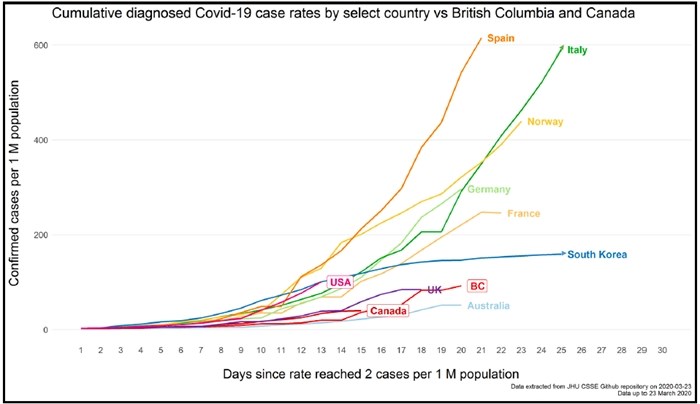
Image Credit: Shutterstock
March 27, 2020 - 5:30 PM
Prevention through things like social distancing is still the best way to keep the impact of B.C.’s COVID-19 pandemic to a minimum.
But, as the number of new cases keeps growing, it’s also crucial that the province’s health care system – including Interior Health — is prepared to handle the worst case scenario for what Provincial Health Officer Dr. Bonnie Henry calls “B.C.’s own pandemic.”
During a detailed media briefing today, March 27, she and others outlined how many hospital beds will be needed in each health region given a best case scenario (using South Korea as a model) versus a worst case scenario (Northern Italy).
The numbers below refer to acute care beds available in B.C.’s 17 largest hospitals but the report did not specify which Interior hospitals are on that list.
As of yesterday, there were 66 COVID-19 patients in acute care beds in all of B.C., including 26 in intensive care units.
With the cancellation of elective surgeries, there are now an average of 110 vacant acute care beds in the Interior Health region, about 10 per cent of 1,007 such beds.
Under a best case scenario, at the pandemic’s peak, there will only be 17 people in the region who will need acute care beds.
In a worst case scenario, there will be 507 COVID-19 patients needing acute care beds, leaving the region 397 beds short.
Should that happen, some non-COVID-19 patients could be moved out of those hospitals into suitable facilities in the community to free up beds.
Setting up such facilities is starting in the Lower Mainland next week. No word was given on when that will start happening in the Interior.
Another option is to put patients in some of B.C.’s 35 other hospitals. That will create some transportation issues so work is being done to make sure ambulances have enough ventilators.
In other countries that are further ahead in the epidemic cycle, it’s been shown that critically ill people who are put on ventilators earlier in their illness recover faster.
The province, therefore, is buying more ventilators while it repairs and upgrades others.
There are currently 77 adult critical care ventilators in the Interior Health region with an average of 39 being used daily.
Under a best case scenario, only five ventilators will be needed for COVID-19 patients in the Interior so there are plenty available.
But, under a worst case scenario, 63 COVID-19 patients will need ventilators, creating a shortfall of five ventilators.
Since the Interior and Vancouver Island health regions have older populations than in other parts of the province, the focus is on getting more ventilators to those regions.
The other front that is of concern to health officials is the shortage of personal protective equipment, like masks.
While the province is trying to find more, Henry said that health care workers are changing the way they use such equipment to make sure there will be enough when needed.
For example, if all patients with similar illnesses are put on the same ward, nurses won’t have to change equipment every time they move to another patient to prevent the spread of disease. That not only uses less equipment but is safer for nurses who are at greatest risk when changing.
THE BIGGER PICTURE
The report showed that B.C. has about 1,000 available acute care beds right now.
Under a best case scenario, 90 of those beds will be needed.
Under a worst case scenario, 2,746 of these beds will be needed, leaving a shortfall of 1,778 beds.
The presentation included comparisons of B.C. versus other countries, some of which are further along in the outbreak.
This graph shows how the number of cases spiked in other countries. The graph lines start after there were two confirmed cases per one million residents.
The data is a couple of days old so doesn't reflect the recent spike of cases in the United Kingdom.

Image Credit: Submitted/Ministry of Health
Henry said B.C. seems to be faring better than places like Italy but the province is still in the early stages. The peak is usually reached 29 days after the first 100 cases are confirmed. B.C. is at about 21 days.
She stressed the need to continue to self-isolate and to only venture out when necessary for what could be weeks more to come.
To contact a reporter for this story, email Rob Munro or call 250-808-0143 or email the editor. You can also submit photos, videos or news tips to the newsroom and be entered to win a monthly prize draw.
We welcome your comments and opinions on our stories but play nice. We won't censor or delete comments unless they contain off-topic statements or links, unnecessary vulgarity, false facts, spam or obviously fake profiles. If you have any concerns about what you see in comments, email the editor in the link above.
News from © iNFOnews, 2020